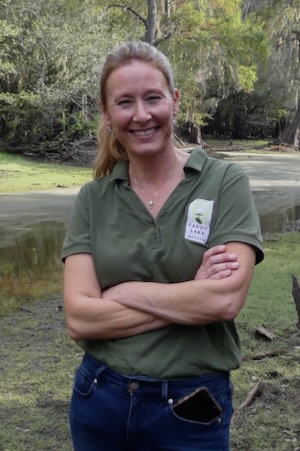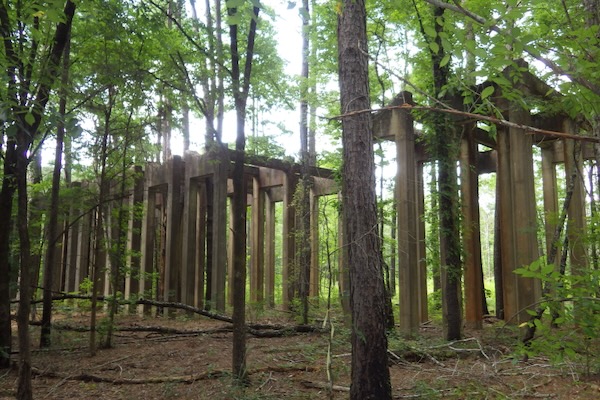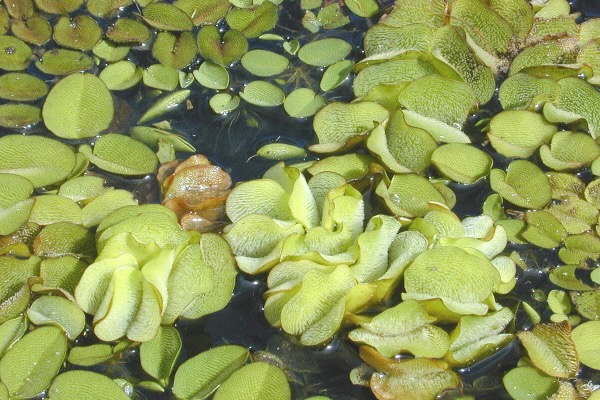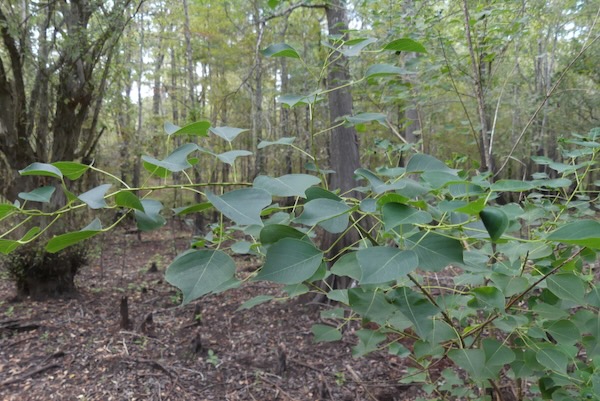
East Texas native Don Henley started the Caddo Lake Institute in 1993. Above, lotus and bald cypress trees on Caddo Lake. Photo by Michael Smith.
Nov. 29, 2023
This article is part of an occasional series spotlighting environmental stories from across the Lone Star State.
 Our canoe slipped quietly through the water among bald cypress trees draped in Spanish moss. We floated among big lotus leaves and paddled under towering cypress branches with their feathery green leaves, which provided a shaded refuge. Here at Caddo Lake, among the ancient trees, you can slip away from the 21st century, at least for a while.
Our canoe slipped quietly through the water among bald cypress trees draped in Spanish moss. We floated among big lotus leaves and paddled under towering cypress branches with their feathery green leaves, which provided a shaded refuge. Here at Caddo Lake, among the ancient trees, you can slip away from the 21st century, at least for a while.
But despite its peacefulness, the natural lake, estimated to have formed more than 200 years ago, has faced underlying threats brought on by human development over the last century.
On a recent visit, we met up with the director of the Caddo Lake Institute. The nonprofit, founded in 1993 by a famous singing Eagle, has been a powerful voice for the ecosystem for the last 30 years.
Courtesy of Texas Parks and Wildlife Department.UNIQUE NATURAL LAKE
The 25,000-acre lake in East Texas is said to be the only naturally formed lake in the state, meaning that it was not made by humans like the state's other reservoirs.
Hundreds of years ago, periodic flooding eroded soil so that trees fell into the waterways and drifted downstream. These trees formed a “great raft” that impeded the water’s flow and raised the water level, forming Caddo Lake at the Texas-Louisiana border. These days, it does have a spillway, but that is not how it was formed.
Big Cypress Bayou drains into the western end of Caddo Lake. The boundaries between land and water seem to blur, with cypress swamps and seasonally flooded bottomland forests tracing the serpentine path of the bayou. Some of these areas fall within the Caddo Lake Wildlife Management Area, Caddo Lake State Park or the Caddo Lake National Wildlife Refuge. Those places help protect the bayous and woodlands.
THREE DECADES OF PROTECTION
 Laura-Ashley Overdyke is the executive director of the Caddo Lake Institute. Photo by Michael Smith.
Laura-Ashley Overdyke is the executive director of the Caddo Lake Institute. Photo by Michael Smith.
The Caddo Lake Institute, founded in 1993, is dedicated to the lake and its surrounding land with the mission of “protecting the ecological, cultural and economic integrity of Caddo Lake.”
The Institute helps knit together the efforts of Texas, Louisiana and federal government agencies.
“Caddo Lake Institute is the glue,” explained Laura-Ashley Overdyke, executive director of the Institute. “We look at the big picture and fill in the gaps — either with funding or researchers. We work with local residents and help them know what’s possible and trust that it can work out OK for them.”
Then, she said, they get government agencies to come to the table. Those agencies include the U.S. Army Corps of Engineers, Texas Parks & Wildlife Department, Louisiana Department of Wildlife and Fisheries, U.S. Geological Survey, Northeast Texas Municipal Water District, the U.S. Army, Environmental Protection Agency and Texas Commission on Environmental Quality.
For example, Overdyke said, “The Caddo Lake Institute used to do more water quality testing because the agencies were not doing it very regularly, but with encouragement and leading by example, the Institute got the state agencies to increase the testing.”

Some structures from the shuttered Longhorn Ammunition plant still stand at the Caddo Lake Wildlife Refuge. Photo by Michael Smith.
Such testing is especially important because there is an EPA Superfund site located within the Caddo Lake National Wildlife Refuge.
From 1942 to 1997, it was home to the Longhorn Army Ammunition Plant where first, bombs and later rocket motors and other weapons of war were manufactured. A lot of work has gone into restoring the forest there and a water treatment facility is still working to remove pollutants.
Overdyke said that more than a decade ago, the Institute obtained a grant to hire a contamination expert to explain the Longhorn cleanup process to the community, as the process can be quite confusing. They have quarterly meetings with representatives from the community, the Army and EPA.
EAGLE BACKING
The origin of Caddo Lake Institute can be traced to Don Henley, founding member of the Eagles. He grew up in nearby Linden in East Texas and his father brought him to Caddo to fish. Overdyke said that the beauty and wonder of the lake made a lasting impression. His love of nature deepened in college when he discovered the writings of Henry David Thoreau, author of Walden or Life in the Woods.
“When he was in his 40s, he found that Walden Pond was for sale, and a developer was going to build condos around it,” she said. "Henley was determined not to let that happen. So he bought it and started the Walden Woods Project as a nonprofit.”
Around that time, there were proposals to make a shipping channel through Caddo Lake from Daingerfield to Shreveport and the Red River. To do that, they would have to dredge it to allow barge traffic. Henley’s reaction, according to Overdyke, was “Wait, Caddo Lake is my Walden.” So he started the Caddo Lake Institute.
To demonstrate that a shipping channel’s ecological damage would outweigh the benefits, Henley hired environmental attorney Dwight Shellman, who moved to Caddo Lake and got universities and government agencies involved. They held community meetings and town halls and plans for the channel ended. Henley is still the chairman of the board and one of the biggest donors to the Institute.
INTERNATIONAL IMPORTANCE
In 1993, a portion of the Caddo Lake area was designated as a Wetland of International Importance under the Ramsar Convention on Wetlands. This is based on its status as a rare or unique wetland that supports important species of plants and animals. The designation came about based on a collaboration between the Institute and multiple government agencies.
BATTLING INVADERS
 Caddo Lake is plagued by salvinia, an invasive aquatic plant popular in water gardens. Courtesy of the Caddo Lake Institute.
Caddo Lake is plagued by salvinia, an invasive aquatic plant popular in water gardens. Courtesy of the Caddo Lake Institute.
The ammunition plant is closed and the lake was saved from dredging for barges, but there are still challenges.
“We have the world’s worst invasive aquatic species,” Overdyke said.
It comes in the form of a sort of free-floating fern called giant salvinia. The plant has been distributed worldwide because, unfortunately, it looks pretty in water gardens.
Overdyke continued, “It is so fast-growing and replicates by fragmentation and is not rooted to the bottom. We can’t really eradicate it. We’ve finally accepted that through many hard years of trial and error.”
The Institute brought in a harvester that could pull salvinia out of the water, but it removed salvinia at a rate slower than the plant grew, so that was not a workable option.
Overdyke said that they asked themselves where salvinia came from and what works there? It turns out that in the plant’s native Brazil, there is a weevil that eats nothing but salvinia. That is a crucial bit of information. If the weevil was released here and it ate native plants or crops, that would constitute a new problem. But it just eats salvinia.
And so the Institute helps support another local nonprofit that grows salvinia in a greenhouse with weevils already feeding on it. When the weevils get to a certain density, they gather the infested salvinia in totes, take them to an area that cannot be treated with herbicide and release them so the weevils will eat the salvinia.
When they can safely do it, they treat mats of salvinia with an herbicide, sometimes including glyphosate.
“We have every reason to believe that this herbicide, if used correctly and applied to the plant, will not persist — it has a very short half-life. It doesn’t build up in wetland soil,” Overdyke said.
Fish should be OK but she said that EPA does not test it on amphibians. The Institute is in contact with the Amphibian Research & Monitoring Initiative to get any available information to prevent harming frogs and salamanders.
It's a matter of weighing the risks and benefits, Overdyke said.
“I’ve likened it to someone who has cancer. If you have a tumor and can cut it out, great. But if not, you need chemo, which can hurt you.”
 Chinese tallow is the one of the invasive plants land managers are battling at Caddo Lake. Photo by Micheal Smith.
Chinese tallow is the one of the invasive plants land managers are battling at Caddo Lake. Photo by Micheal Smith.
In this case, “chemo” is herbicide, applied while monitoring carefully for unwanted effects.
“It’s not perfect, but we can’t let salvinia take over. It would choke out all the native plants. It would block any sunlight from the water column.”
As a result, oxygen levels in the water would drop.
There’s an invader on land as well — Chinese tallow, a small tree that is toxic and crowds out other plants. The tree infests private land along waterways that feed the lake, so that the seed beds may wash down and new invasive trees sprout around the lake. The Institute helps connect landowners with U.S. Fish and Wildlife Service. The agency can reimburse the landowner for about half of the cost of tallow removal.
BRINGING BACK THE PADDLEFISH

The American paddlefish has inhabited Caddo Lake, as well as other rivers and bayous of the Mississippi River Basin, for 350 million years and is the only surviving species of paddlefish on the planet. Courtesy of Caddo Lake Institute.
There’s an ancient and strange-looking fish that has lived in the waters around Caddo Lake since before the dinosaurs walked in Texas. The American paddlefish can grow as long as seven feet and has an odd paddle-shaped snout. It feeds on tiny zooplankton in the water.
The Lake O’The Pines Dam was built in 1959, impounding and regulating the water that flows downstream into Caddo Lake. The paddlefish soon began to decline. Seasonal changes in water flow were needed for their movement upstream for spawning and for suitable habitat needed in the earliest stages of the fish’s life. Many other things depend on those patterns of water flow, with a pulse of water coming downstream after spring rains and lower water levels later in the year. Increased flow in the spring would flush excess sediment and invasive plants away and keep the bottomland forests moist. That pulse of water would trigger spawning in fish.
“Mother Nature really knew what she was doing,” said Overdyke.
The Institute determined that re-establishing a more natural pattern for water flow — the hydrology of Caddo Lake — was key to keeping the whole ecosystem healthy. And so the Institute worked with the Corps of Engineers, Texas Parks & Wildlife Department biologists and others.
“We also needed to hire private hydrologists who worked just for the Caddo Lake Institute,” Overdyke noted, because other agencies have a variety of goals and interests, not just Caddo. The goal was to get the dam upstream to release water in the right amounts and at the right time.
“That took a long time and a lot of consensus-building.”
Restoring the springtime pulse of water is what allowed the Institute to work on restoring paddlefish. With the springtime pulse restored, it became possible for U.S. Fish and Wildlife Service and the state wildlife agencies in Texas and Louisiana to work on re-stocking paddlefish in the lake. It’s a long-term project, but the survival rate of the released fish is encouraging.
MYSTERY, BEAUTY AND RESILIENCE
 Most bald cypress live up to 600 years and some individuals have survived 1,200 years, according to the Texas Parks and Wildlife Department. Photo by Michael Smith.
Most bald cypress live up to 600 years and some individuals have survived 1,200 years, according to the Texas Parks and Wildlife Department. Photo by Michael Smith.
Taking a walk through the forest in the Caddo Lake National Wildlife Refuge, you may see concrete structures from the old ammunition plant emerge from the pines and sweetgum trees. Seeing these relics reminds me that this place is a survivor — strong and resilient. That includes the stately bald cypress trees, the bayous and wetlands and the diverse wildlife living here.
Their survival owes something to the various agencies that keep the bottomlands, swamps and forests protected. And the Caddo Lake Institute keeps tabs on all of it, stepping in to lend a hand and help everyone stay on the same page.
Overdyke put it well:
“We think Caddo’s really special, and we want to be able to hear the frogs at night, and the birds, and see the seasons change and be able to eat the fish out of this lake. We share those values with local residents.”
Stay up to date on everything green in North Texas, including the latest news and events! Sign up for the weekly Green Source DFW Newsletter! Follow us on Facebook,Twitter and Instagram. Also check out our podcast The Texas Green Report, available on your favorite podcast app.









